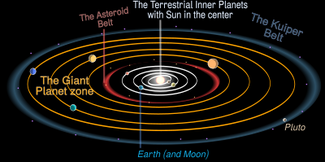What Comprises our Solar System?
Planet sizes to scale; distances not to scale

During the past three decades a myriad of space explorers have escaped the confines of planet Earth and have set out to discover our planetary neighbors. This picture shows the Sun and all the planets of the solar system as seen by the space explorers. Starting on the left is the Sun, followed by the planets Mercury, Venus, Earth, Mars, Jupiter, Saturn, Uranus, Neptune, and the dwarf planets, including Pluto, all shown to scale, though not the correct distances from the sun and each other. The asteroid belt which encircles the sun between the planets Mars and Jupiter, separating the planets into four 'inner' terrestrial planets and four 'outer' gas giant planets ('Jovian planets') of the solar system, is not shown.
"For I dipped into the Future, far as human eye could see; saw the
vision of the world, and all the wonder that would be." Alfred Lord
Tennyson, 1842
Composition Of The Solar System Our solar system consists of an average sized star we call the Sun, the planets Mercury, Venus, Earth, Mars, Jupiter, Saturn, Uranus, Neptune, and Pluto (classified as a dwarf planet). It includes: the satellites of the planets; numerous comets, asteroids, and meteoroids; and the interplanetary medium. The Sun is the richest source of electromagnetic energy (mostly in the form of heat and light) in the solar system. The Sun's nearest known stellar neighbor is a red dwarf star called Proxima Centauri, at a distance of 4.3 light years away. The whole solar system, together with the local stars visible on a clear night, orbits the centre of our home galaxy, a barred spiral disk of 200 billion stars we call the Milky Way. The Sun contains 99.85% of all the matter in the Solar System. The planets, which condensed out of the same disk of material that formed the Sun, contain only 0.135% of the mass of the solar system. Jupiter contains more than twice the matter of all the other planets combined. Satellites of the planets, comets, asteroids, meteoroids, and the interplanetary medium constitute the remaining 0.015%. The following table is a list of the mass distribution within our Solar System.
Interplanetary Space Nearly all the solar system by volume appears to be an empty void. Far from being nothingness, this vacuum of "space" comprises the interplanetary medium. It includes various forms of energy and at least two material components: interplanetary dust and interplanetary gas. Interplanetary dust consists of microscopic solid particles. Interplanetary gas is a tenuous flow of gas and charged particles, mostly protons and electrons -- plasma -- which stream from the Sun, called the solar wind.
The solar wind can be measured by spacecraft, and it has a large effect
on comet tails. It also has a measurable effect on the motion of
spacecraft. The speed of the solar wind is about 400 kilometers
(250 miles) per second
in the vicinity of Earth's orbit. The point at which the solar wind
meets the interstellar medium, which is the "solar" wind from other
stars, is called the heliopause. It is a boundary theorized to be
roughly circular or teardrop-shaped, marking the edge of the Sun's
influence perhaps 100 AU from the Sun. The space within the boundary
of the heliopause, containing the Sun and solar system, is referred to
as the heliosphere.
The solar magnetic field extends outward into interplanetary space; it can be measured on Earth and by spacecraft. The solar magnetic field is the dominating magnetic field throughout the interplanetary regions of the solar system, except in the immediate environment of planets which have their own magnetic fields. The Terrestrial Planets 
The terrestrial planets are the four innermost planets in the solar system, Mercury, Venus, Earth and Mars. They are called terrestrial because they have a compact, rocky surface like the Earth's. The planets, Venus, Earth, and Mars have significant atmospheres while Mercury has almost none. The diagram on the left shows the approximate distance of the terrestrial planets to the Sun. The Jovian Planets

Jupiter, Saturn, Uranus, and Neptune are known as the Jovian (Jupiter-like) planets, because they are all gigantic compared with Earth, and they have a gaseous nature like Jupiter's. The Jovian planets are also referred to as the gas giants, although some or all of them might have small solid cores. The diagram on the right shows the approximate distance of the Jovian planets to the Sun. http://www.solarviews.com/eng/solarsys.htm#comp |





